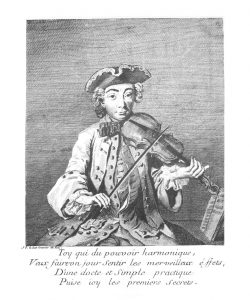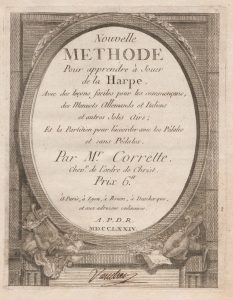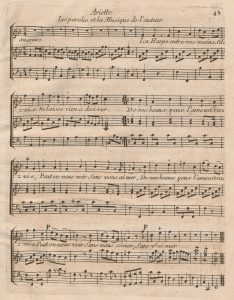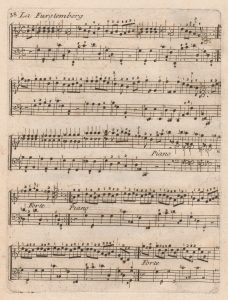A lost eighteenth-century harp method rediscovered, Michel Corrette’s Nouvelle méthode pour apprendre à jouer de la harpe (1774): A new acquisition for Rare Music
Published in Paris in 1774, Michel Corrette’s Nouvelle méthode pour apprendre à jouer de la harpe [New method for learning to play the harp] is an exciting new addition to the Rare Music collection. Until recently it was considered to be a ‘lost’ eighteenth-century harp method since scholars were unable to locate any reference to this rare edition in the major European bibliographies or at auction. Michel Corrette (b Rouen, 1707; d Paris, 1795) is well known among musicians and scholars of eighteenth-century French music for his work as an organist, teacher, prolific composer-arranger with works spanning 75 years, and as an author of pedagogical methods for various instruments and voice. These methods are clearly written and well-structured, offering valuable insight into aspects of eighteenth-century French performance practice. For example, the pieces included in his violin method L’école d’Orphée (1738), which illustrate the French and Italian styles, help us to further understand the complex discourse of national styles in this period and its musical application.
Michel Corrette (b Rouen, 1707; d Paris, 1795) is well known among musicians and scholars of eighteenth-century French music for his work as an organist, teacher, prolific composer-arranger with works spanning 75 years, and as an author of pedagogical methods for various instruments and voice. These methods are clearly written and well-structured, offering valuable insight into aspects of eighteenth-century French performance practice. For example, the pieces included in his violin method L’école d’Orphée (1738), which illustrate the French and Italian styles, help us to further understand the complex discourse of national styles in this period and its musical application.
The subtitle of Corrette’s harp method, Avec des leçons faciles pour les commençans, des menuets allemands et italiens et autres jolis airs; et la partition pour l’accorder avec les pédales et sans les pédales [with easy lessons for beginners, German and Italian minuets and other pretty airs; and a section for tuning pedal and non-pedal harps] indicates a similar clarity of structure to his other pedagogical works. The work begins with a brief history of the harp. This is followed by fourteen chapters on chords, fingering on the harp, arpeggios, and the use of the pedals. Other eighteenth-century French harp methods from 1763 onwards address similar aspects of history, technique and musical execution for the instrument and most are aimed at beginners, demonstrating that Corrette’s method could be considered representative of the approach to pedagogy for the harp in this period.
The harp which is the focus of this method, is known today as the ‘single-action harp’ and in late-eighteenth century Paris as ‘harpe organisée’ or ‘harpe à pédales’. This instrument was revolutionary at the time in being the first harp with a mechanism that allowed the player to alter the pitch of the strings by pressing pedals with their feet. The seven pedals attached to rods in the harp’s column, which in turn engaged a mechanism in the instrument’s neck, could raise the pitch of each string by one semitone (hence the term ‘single-action), thus leaving both hands free for playing continuous scales and arpeggio figures whilst modulating to various keys. For harps of earlier periods, chromaticism was achieved by various means such as shortening the pitch of the string with a finger whilst playing with the opposing hand, adjusting the pitch of individual strings with a tuning key, increasing the single row of strings to two or three ranks which included a chromatic row, and hooks attached to the neck of the harp which could be turned with one hand to shorten the string. The first harp with pedals is attributed to a German luthier Jacob Hochbrucker as early as 1697 but it was not until 1749 that there is the first documented performance on this instrument in France at the ‘Concert Spirituel’ season in Paris. By the time the first pedal harps by Parisian maker Salomon were available for sale in 1760 the single-action harp had become a wildly popular commodity as described in an oft-quoted letter from Charles-Simon Favart to the Count Durazzo on May 1, 1761.
“La harpe est aujourd’hui l’instrument à la mode; toutes nos dames on la fureur d’en jouer.”1
[Today the harp is the instrument à la mode; all our ladies are mad to play it.]
Attuned to the musical and social zeitgeist, Corrette’s method reflects this trend for learning the harp as a popular accomplishment among young aristocratic women, one which would undoubtedly render them more marriageable as it was both beautiful to play and to look at and could only serve to highlight the beauty and charm of the player! The frontispiece of the method features an engraving of a young woman playing a harp accompanied by the following suitably amourous quatrain:
“La Harpe entre vos mains Silvie,
Ne laisse rien à désirer.
De vos beaux yeux l’ame est ravie,
Peut-on vous voir sans vous aimer!”2
[The harp in your hands Silvie,
Leaves nothing to be desired.
A glance at your eyes thrills me
How could you not be admired!]
Corrette neatly sets the text of this poem to music at the end of his harp method in a section containing settings of various popular airs with harp accompaniment. The single-action harp along with the harpsichord and later the fortepiano became one of the most popular instruments to accompany the voice in France in the second half of the eighteenth-century.
The acquisition of this fascinating harp method is directly linked to an Australian Research Council Discovery Project initiated by University of Melbourne Senior Lecturer in Music Dr Erin Helyard, musicologist, historical keyboard specialist and acclaimed performer and conductor. Titled ‘Performing Transdisciplinarity’, this research project is a cross-institutional and interdisciplinary collaboration between ANU (Glenn Roe and Robert Wellington), The University of Melbourne (Erin Helyard), The University of Sydney (Mark Ledbury), and Oxford University (Nicholas Cronk).
This team will undertake a groundbreaking study of the eighteenth-century songbook by Jean-Benjamin de Laborde, Choix de Chansons (1773). Using a research methodology drawn from art history, French literature, musicology and the digital humanities, this study will engage with and enact the complex transdisciplinary and transmedial nature of this text and of eighteenth-century print culture in general whilst also mirroring the multimedia experience of the eighteenth-century consumer with the creation of a digital edition, which weaves together image, text and music. The music in Laborde’s Choix de Chansons features harp and harpsichord accompaniment and Corrette’s harp method, also published in Paris only one year later, will provide important musicological insight into performance practice for the harp at this time and a deeper understanding of how Laborde’s chansons can be meaningfully interpreted.
Hannah Lane, Research Assistant to Dr Erin Helyard
1 Charles-Simon Favart, Mémoires et correspondance littéraires: dramatiques et anecdotiques, de C. S. Favart, ed. Henri Françoi Dumolard, vol. 1 (L. Collin, Paris, 1808), 147.
2 Michel Corrette, Nouvelle méthode pour apprendre à jouer de la harpe, (s.n., Paris, 1774).




Leave a Reply